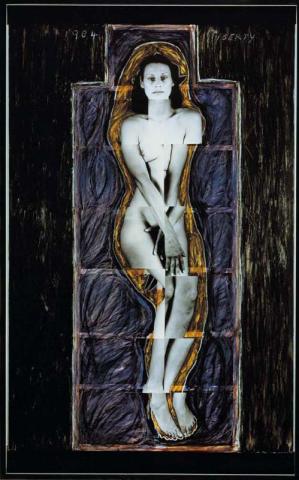Rrap's Puberty (from 'Persona and shadow' series)
By Sarah Tiffin
September 1993
A common thread has run through Julie Rrap's work since the early 1980s. Adopting the post-modernist strategy of borrowing an artistic style or image from the past, Rrap creates new images and meanings that comment upon or question the present. Puberty is an image from the 1984 series 'Persona and Shadow'. The series consists of nine large-format cibachrome prints in which the artist assumes various poses that refer to and echo well-known works by the Norwegian artist Edvard Munch (1863–1944). Black and white photographs have been collaged in a grid-like construction within the silhouette of a Munch image that Rrap has painted with the free expressionistic brushstrokes characterising Munch's work. The whole has then been re-photographed and printed in cibachrome, giving the work a lush, rich intensity.
Puberty reflects several of the key concerns of art practice in the 1980s. During this decade photographers challenged the dominant position that artistic tradition allocates to painting by creating studio-based and highly manipulated photographs on a large scale. Photography could no longer be perceived as purely journalistic. More pertinent to Rrap's work, however, is the feminist stance that gained wide popularity in art theory and criticism during the 1980s. This stance questions a history of art that is dominated by the masculine and in which there are few female role models. The usual pattern of artistic collaboration between the sexes has seen the female as model for the male artist, creating an uneven power relationship in which the feminine is relegated to a subordinate position.
In works such as Puberty, Julie Rrap comments on, by participating in, a history of art in which feminine participation is largely absent or ignored. In an attempt to fill this void, Rrap literally enters art history by photographing herself posed within iconic images from the past. By using what feminist critics consider the most stereotypical of art genres, the female nude, Rrap questions the validity of the roles that art history assigns to women. That Rrap should engage the work of Edvard Munch (c.1894–95) in this way is understandable, particularly in the light of his extreme attitudes towards women. Munch's relationships with women were complex and his paintings, prints and poetry reveal an individual acutely troubled by anxieties. To him, woman was a sexually aggressive force with the power to seduce, victimise and destroy the weaker male. This led Munch to depict women in the stereotypical roles of virgin, mother and whore:
Woman in her manysidedness . . . a mystery to man — Woman who is at one and the same time a saint, a whore and an unhappy person abandoned.'
Munch's painting 'Puberty' is a disquieting work of a young girl's emerging sexuality. A subject he returned to on several occasions and in a variety of media, Munch first painted this image of dark, brooding intensity in the mid-1880s. With an oppressive and foreboding shadow at her shoulder, the girl's face expresses fear of the unknown as she engages the spectator in her unsettling gaze. In an attempt to shield, her pose exposes a consciousness of sexual difference, of awakening and of anxiety. In Julie Rrap's re-enactment of the work, however, an entirely different relationship is constructed. Taking on the role of both artist and model, Rrap subverts the power balance, placing the subject in control. Although she is naked, she is not vulnerable — her eyes meet the spectator's in challenge, not fear. No longer is this work a voyeuristic image over which masculine fantasies and anxieties can be played; the female's body is now displayed on her own terms. The roles of spectator and subject are inverted through the directness of her gaze.
Sarah Tiffin, former Curatorial Assistant, International Programs, QAGOMA.
